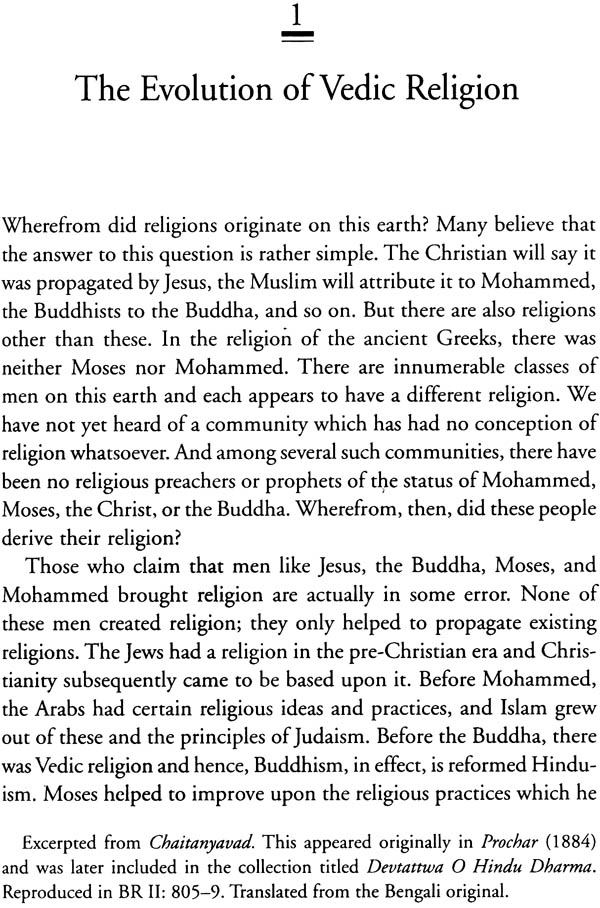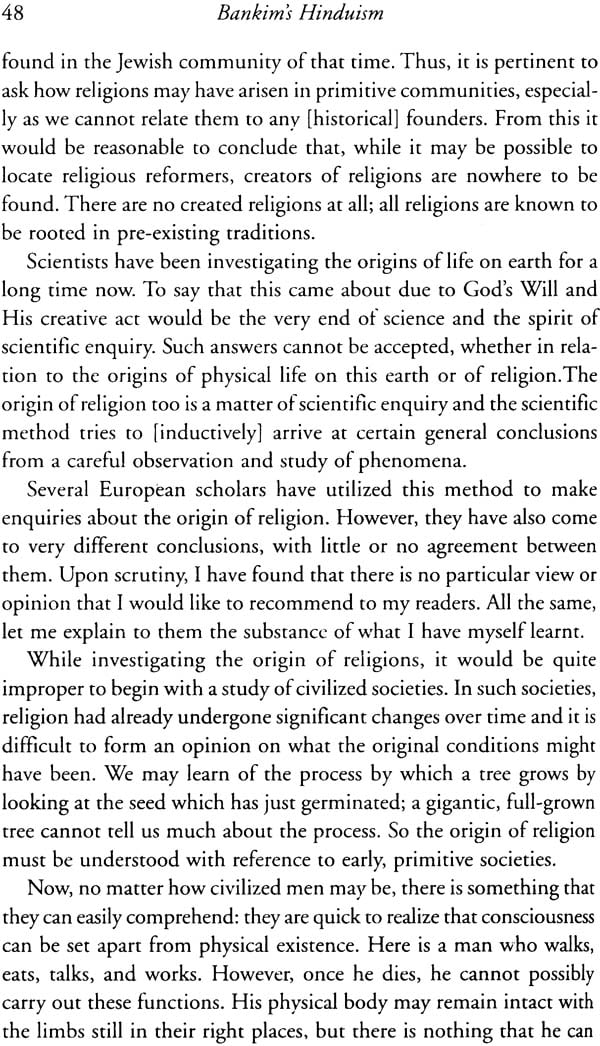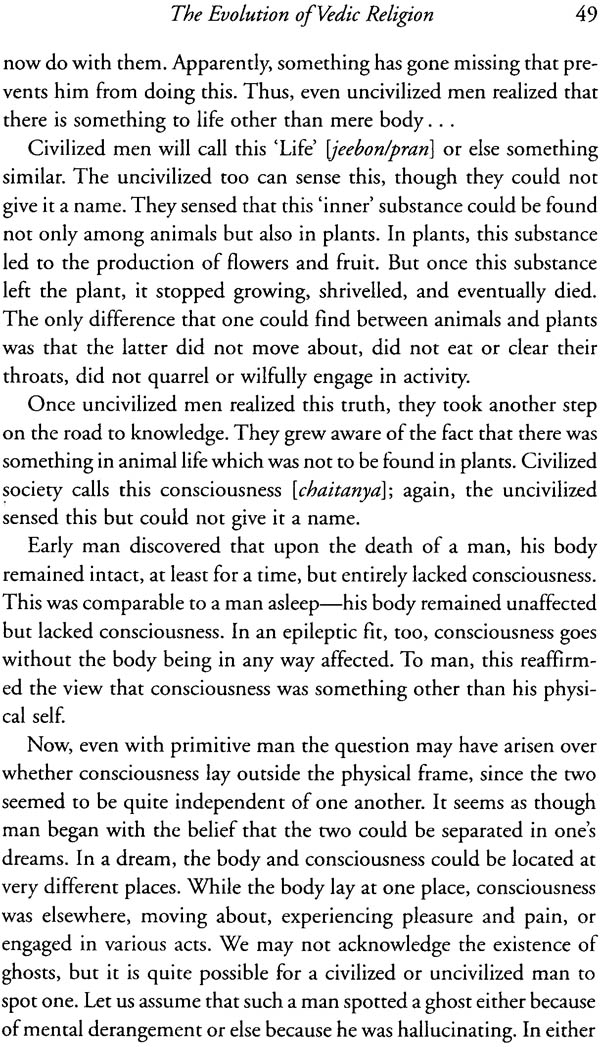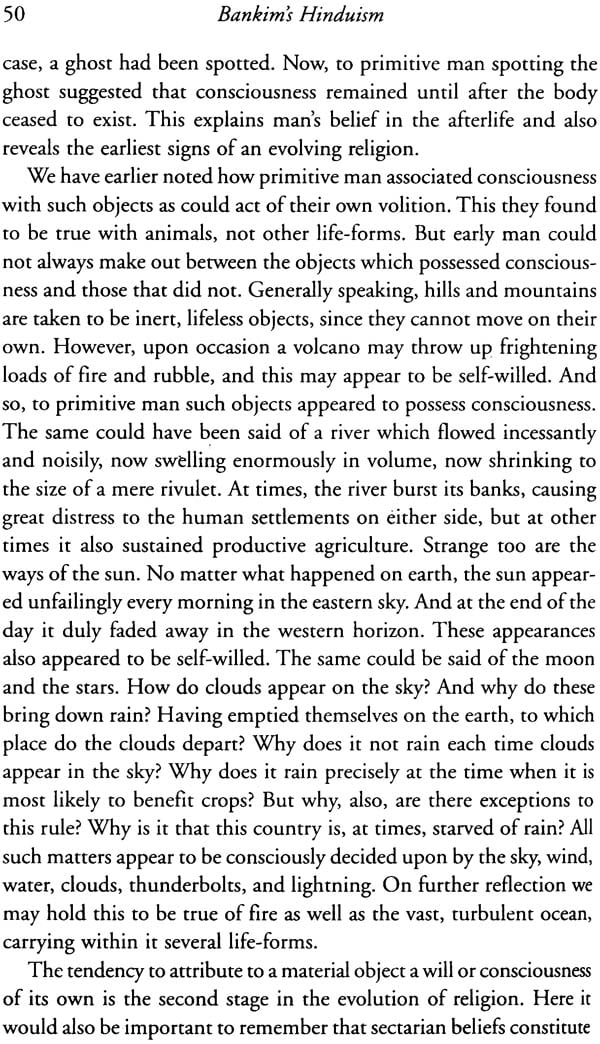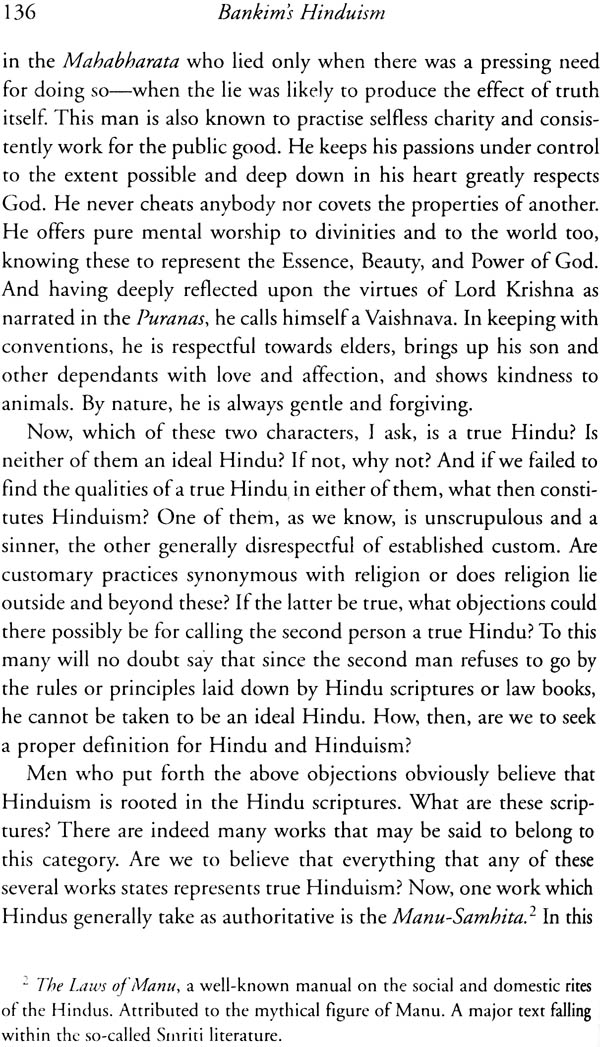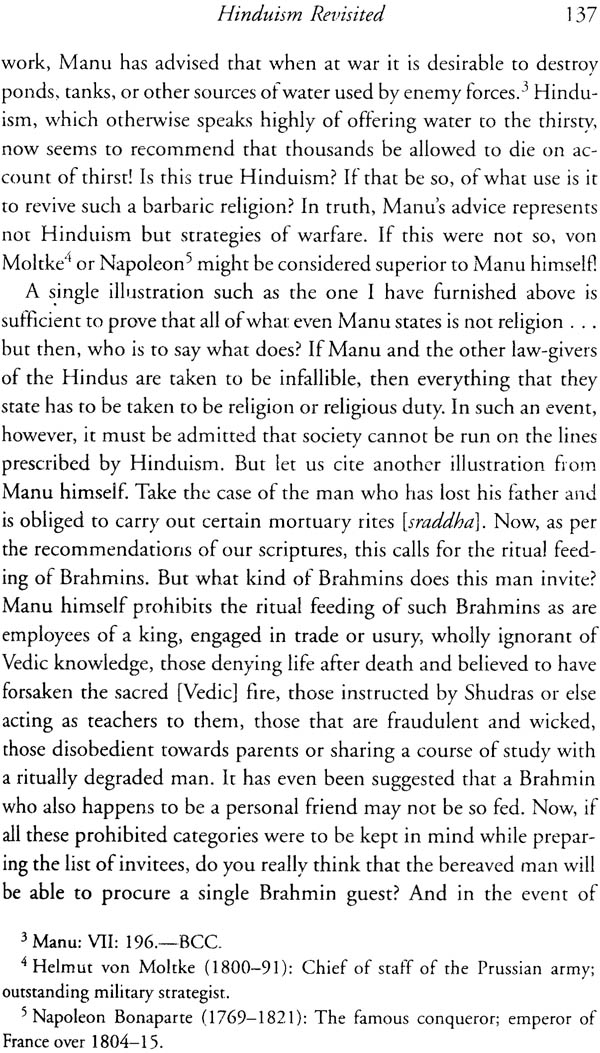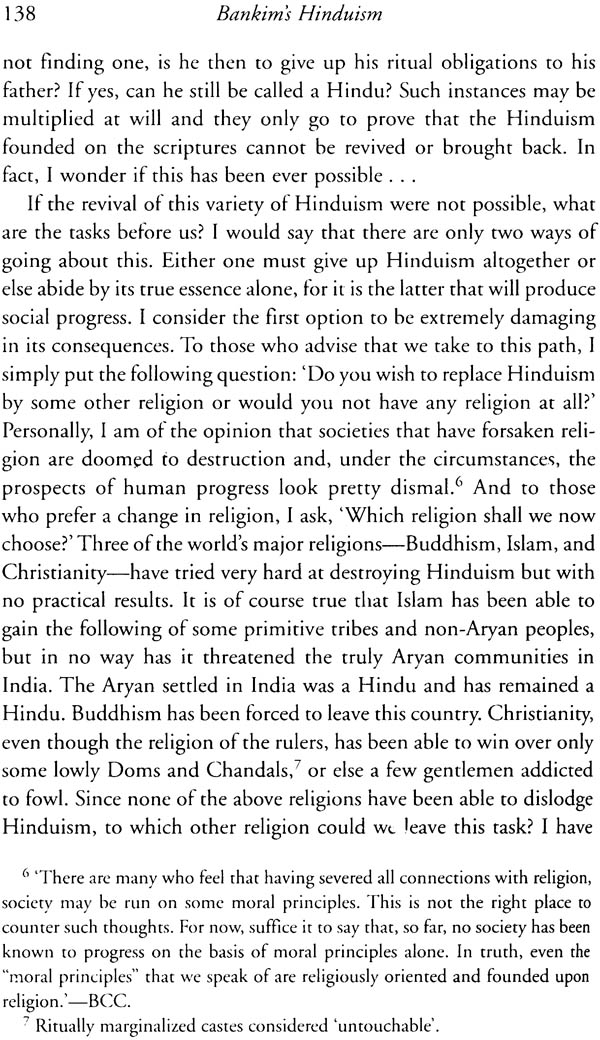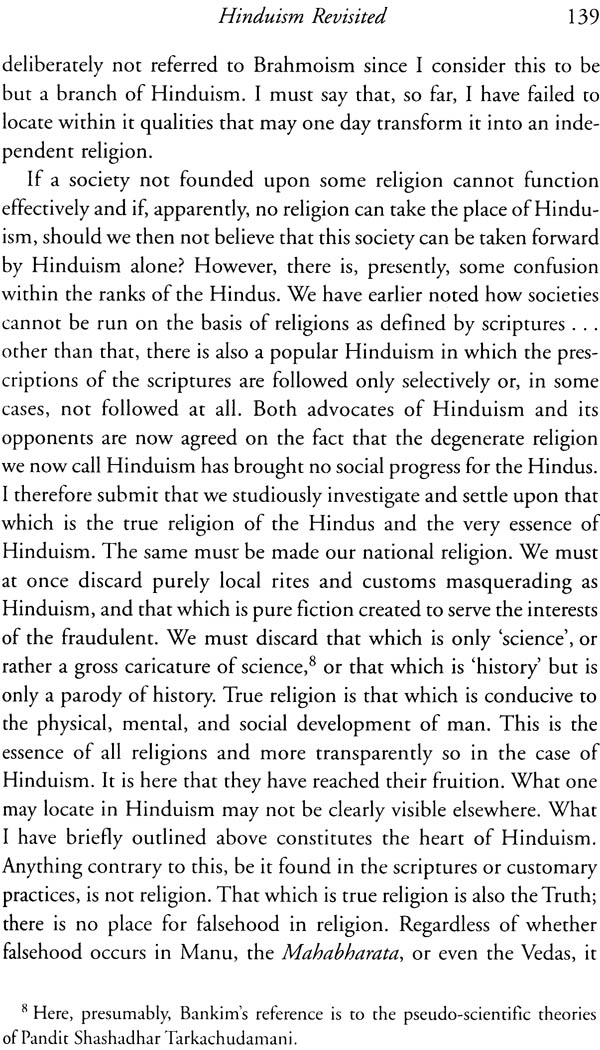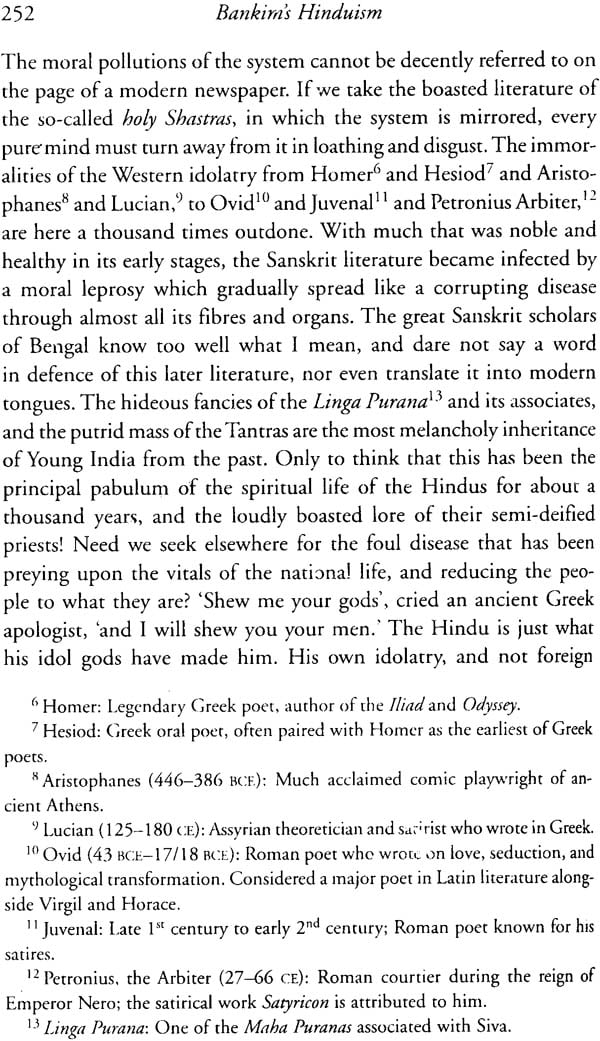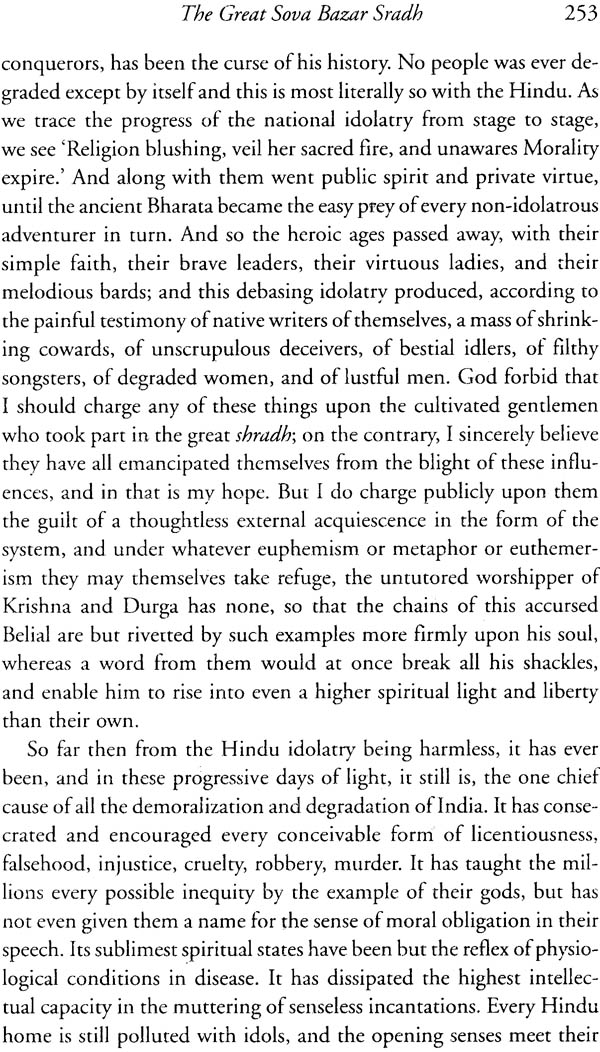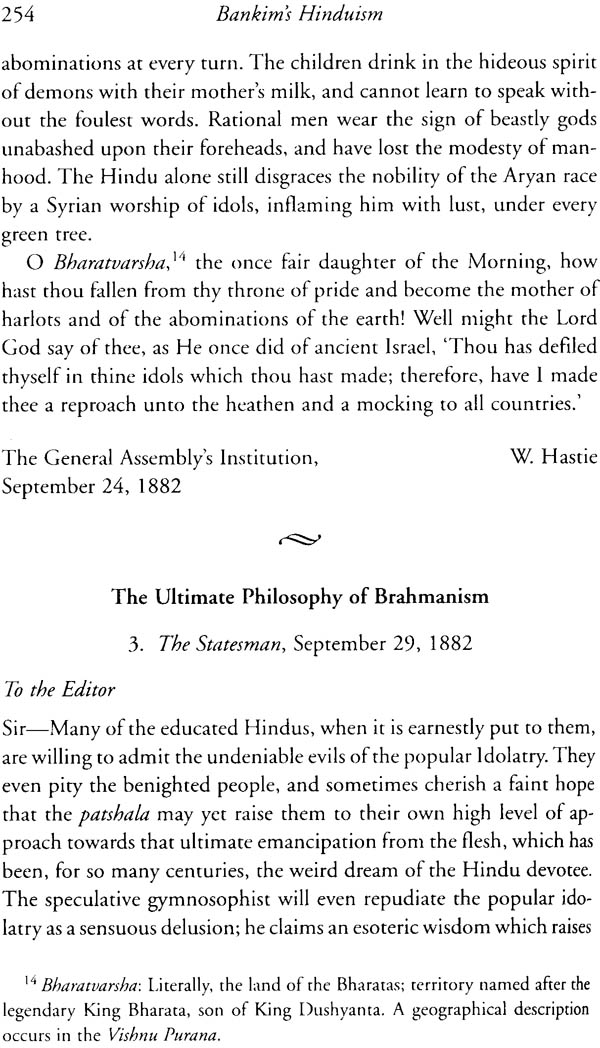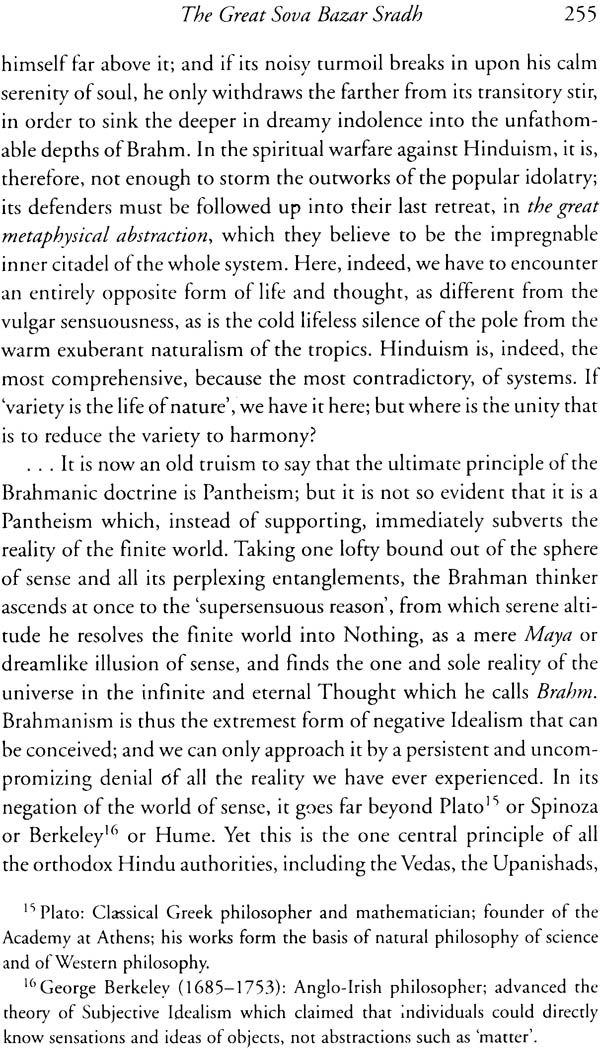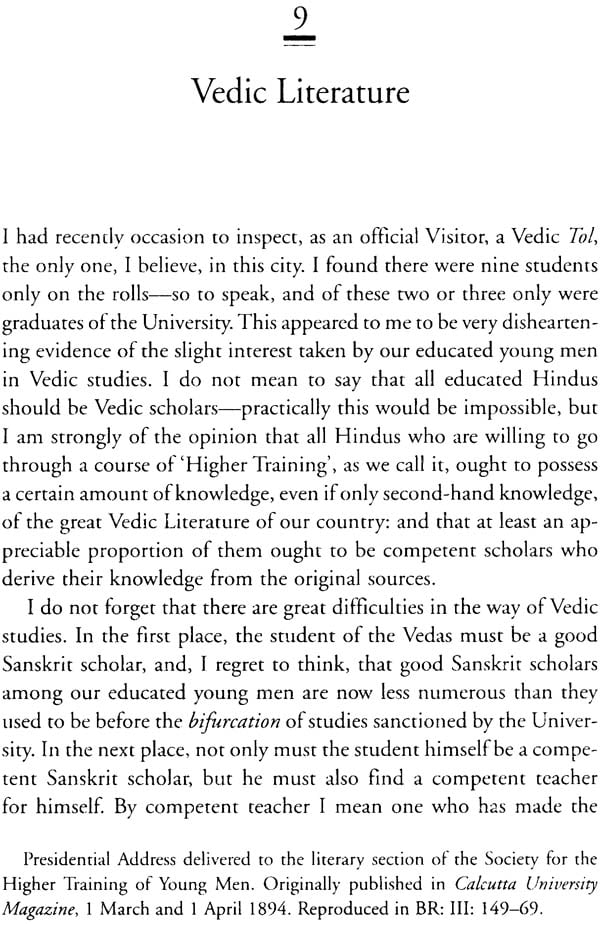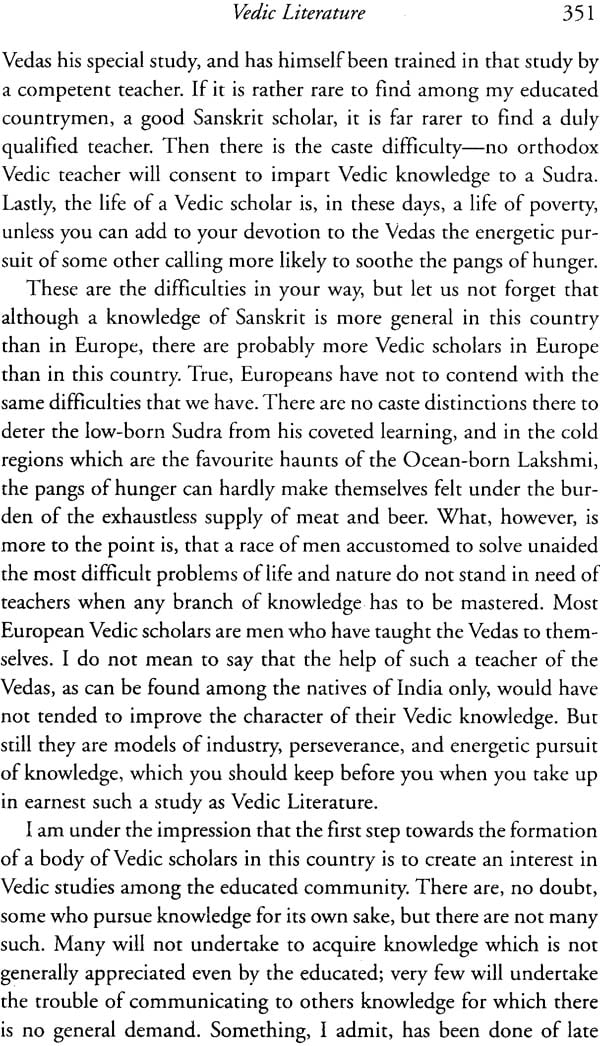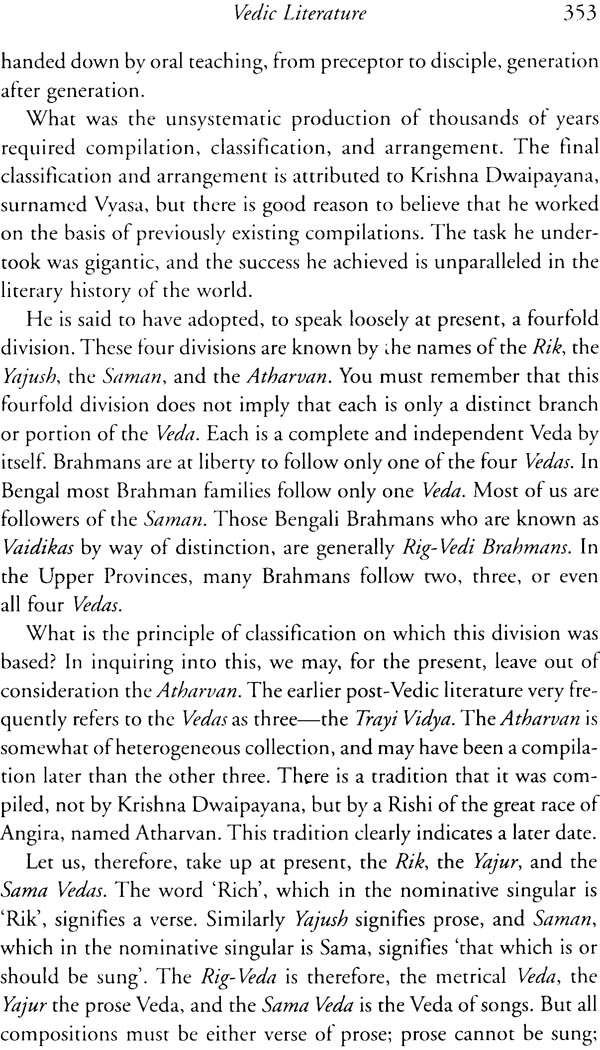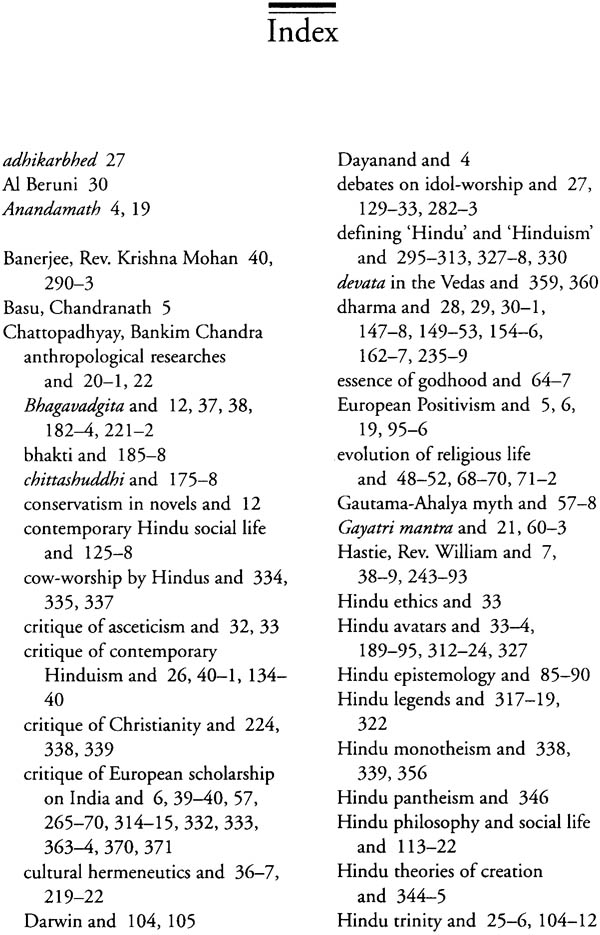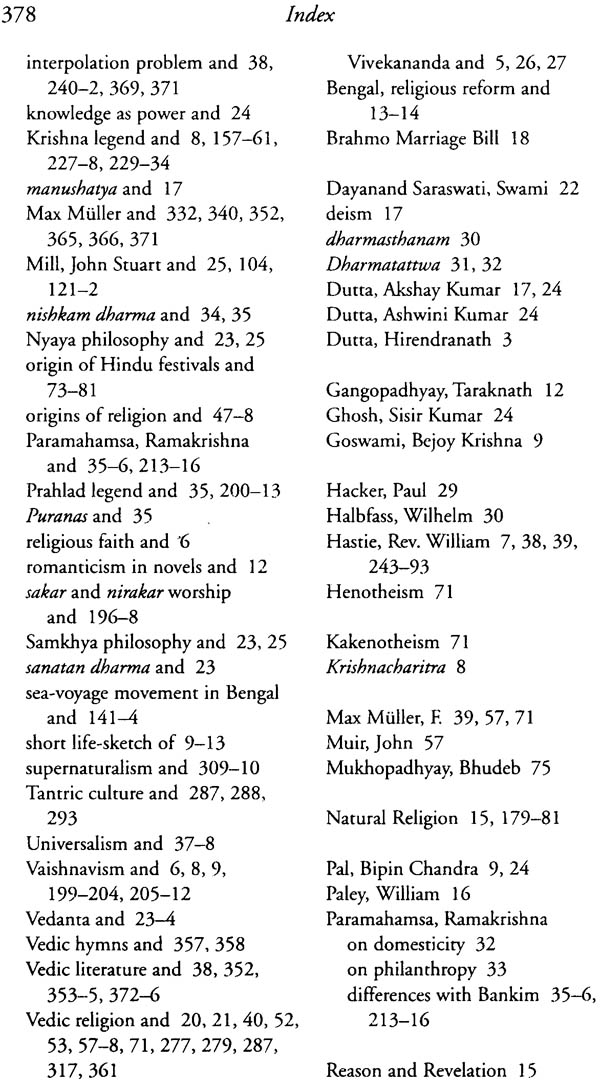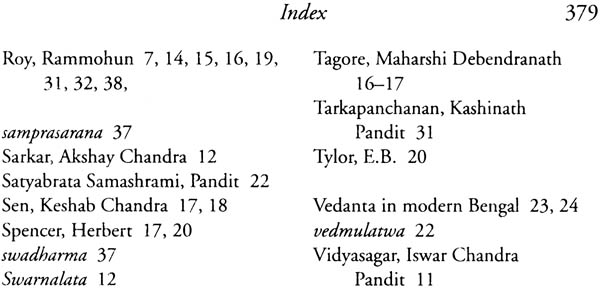
Bankim's Hinduism (An Anthology of Writings by Bankim Chandra Chattopadhyay)
Book Specification
| Item Code: | NAF836 |
| Author: | Amiya P. Sen |
| Publisher: | Permanent Black |
| Language: | English |
| Edition: | 2011 |
| ISBN: | 9788178243238 |
| Pages: | 391 |
| Cover: | Hardcover |
| Other Details | 9.0 inch X 5.5 inch |
| Weight | 610 gm |
Book Description
The great novelist and thinker Bankim Chandra Chattopadhyay (1838-94), associated with his famous hymn ‘Vande Mataram’, is sometimes seen as mainly a creator of Hindu nationalist icons. This is unfortunate, for Bankim was an enormously learned man, a deep and subtle thinker. A relatively unknown side of his work comprises his religious and philosophical thought, in particular his carefully argued ideas on Hinduism.
This collection of Bankim’s writings-many translated into English for the first time and excerpted from the author’s Complete Works in the Bengali original-brings out some of the inner anxieties and ambivalence within the novelist-intellectual’s work on religion, ethics, and philosophy.
By reading this book one may detect in Bankim a rational-functionalist approach to religion, as also a deepening faith and piety transcending that intellectual perspective. Bankim anticipates contemporary scholarship in claiming that Hinduism is the common name given to a variety of religious thoughts and practices; and yet, paradoxically, his writings-all from the colonial era of Indian subjecthood-also argue for a common Hindu heritage, as well as a unified religious and cultural world for contemporary Hindus.
A Substantive Introduction and detailed annotations help to situate Bankim’s life and thought in his times.
Amiya P. Sen was educated at St Stephen’s College, Delhi. He is Professor of Modern Indian History, Department of History and Culture, Jamia Millia Islamia, New Delhi. He has been Agatha Harrison Fellow at the University of Oxford, and Visiting Fellow at the Indian Institute of Advanced Study, Shimla. His several publications include Hindu Revivalism in Bengal: 1872-1905: Some Essays in Interpretation; Explorations in Modern Bengal c. 1800-1900; and, as editor, The Indispensable Vivekananda: An Anthology for Our Times.
The subject of this book was suggested to me by Rukun Advani of Permanent Black, but underlying it is an idea that goes back to the time I completed my short biography of Bankim Chandra (Bankim Chandra Chattopadhyay: An Intellectual Biography, Delhi, Oxford University Press, 2008). At the time, knowledgeable critics had written to say that while the biography excelled at dealing with the political and religious thought of Bankim, it had somewhat neglected his literary accomplishments. I accept this criticism entirely, though my intention, all along, had been to write an intellectual biography and not a literary one. This is also what the subtitle of the work had claimed and, indeed, I had begun writing the biography on the strength of my conviction that there was more to Bankim than his novels. The suggestion that I anthologize Bankim’s writings on Hinduism has encouraged me to further develop aspects that personally most interest me.
The bulk of this collection of writings and speeches from Bankim’s oeuvre is made up of translations from the original Bengali. Some of these have probably been translated for the first time and, hopefully, will prove useful to those general readers and scholars who remain interested in the religious and moral discourse of Bankim Chandra but who have felt handicapped by the lack of apt and adequate translations. To Bankim’s words I have added some of my own, in the shape of a substantive introduction which is broadly divided into two parts. The first presents a short life-sketch of Bankim but, more importantly, locates his religious and moral thought within the reigning discourse of the time. In the second part I offer brief but critical introductions to each of the six sections that comprise selections from Bankim.
Though under different thematic heads, the considerable overlap of ideas and arguments between them is unavoidable. This is a point that I especially wish to emphasize because, even allowing for meaningful changes in Bankim’s thought over time, one must be careful not to overlook deeper continuities.
Apparently, Bankim was somewhat dissatisfied with the term ‘Hinduism’, which he took to represent a degenerate form of a once exalted religious and moral culture. To the latter he preferred to give the name ‘Sanatan Dharma’, much in the fashion of the orthodox. The odd thing, though, is that in his religious thinking he was also innovative and unorthodox. One of the underlying intentions of this work is to bring out more explicitly such inconsistencies which, I believe, characterized the Hindu self-reflexivity of the time.
Research for this project was made possible by a travel cummaintenance grant offered by the UGC-sponsored DRS-SAP run by the Department of History and Culture, Jamia Millia Islamia, and I take this opportunity to thank all those concerned for their generosity and encouragement.
The religious life and thought of Bankim Chandra Chattopadhyay (1838-94) has rarely been the subject of critical scholarship. His first biography, by Sachis Chattopadhyay (1911), chose not to engage with this theme and only in that biography's second edition (1915) were about eleven pages added on this area. Even so, while snippets and short personal accounts by Bankim's contemporaries or near con- temporaries have yielded some further information, on the whole the treatment of this aspect of his life and work looks inadequate. Perhaps the only full-length study of his religious and philosophical thought remains Hirendranath Dutta's Darshanik Bankim Chandra (1940).
With hindsight, there seem to be three reasons for this apathy or lack of interest. First, Bankim's standing as a religious thinker is greatly overshadowed by two other aspects of his life and work. He is seen quite justly as Bengal's first major novelist whose literary fame hinged on his use of a more entertaining prose than that of his predecessors, and his captivating dramatization of human character. To an extent, his journalistic success was also tied to the popularity of his novels. The monthly journal Bangadarshan (launched in 1872) was eagerly awaited in Bengali homes because most of his novels were serialized in it. This somewhat obscures the fact that, through the same journal, Bankirn and his fellow writers also introduced to the Hindu Bengali intelligentsia the very best by way of ideas in their own tradition as well as those which they gathered from the contemporary West.
Secondly, and related to this, was the other form in which Bankim Chandra was widely known (in Bengal as well as beyond)-as the author of the song 'Vande Mataram'. Here too the burgeoning patriotic sentiment of the Hindu middle classes made the novelist, and the novel in which it appeared (Anandamath, 1882), hugely popular, even if purely as a work of fiction Anandamath compares poorly with Bankim's other novels.
The third reason is that Bankim's writings on the religious life and thought of the Hindus were often at odds with contemporary Hinduism. Firm and forthright in his convictions, Bankim never hesitated to speak his mind even when what he stated ran counter to reigning belief and practice. Some of his contemporaries even testified to the fact that Bankim's knowledge of religious literature in contemporary Bengal was weak, and that he cared little for the debates generated around it. Though posterity has often associated him (and not unreasonably) with cultural revivalism, there were few men in Bengal who also critiqued this idea as seriously. Bankim was quite intolerant of the 'crudities' that had crept into Hinduism, as well as of ideas he considered to be thoughtless religious revalidations. The Vedic revival of Swami Dayanand Saraswati (1825-83) he took to be anachronistic and, without being disrespectful of classical philosophers like Acharya Sankara, rejected the possibility of their ideas being accepted uncritically across time. He was polite in his disagreement with the Hindu mystic Ramakrishhna Paramahamsa (1836-86) and with eminent Brahmo theologians of his day, but quick to distance himself from both the pseudo-scientific explanations of Hindu manners and customs as well as the aggressive propaganda launched by some Hindu missionaries in his time. In his day, in fact, from his thought and deeds few would have taken Bankim Chandra to be conventionally Hindu. This is quite consistent with his own confession that, as a young man, he had been an atheist and that his belated interest in Hinduism was something he himself could not satisfactorily explain.
It has also been argued that it was not Hinduism that Bankim commented on, since he scrupulously omitted from his agenda customs or manners commonly followed by Hindus, such as everyday rituals, and belief in rebirth and the afterlife; and that even accommodating the idea of God within his moral and religious discourse was actually a practical concession to placate Hindu sentiments. I will here argue against this view.
There are certainly difficulties in identifying what precisely is theological within Bankim's writings. Some of his contemporaries often expressed their unhappiness at his interest in the 'godless' religion of European Positivists, and his tendency to judge matters mainly on grounds of public utility. In Bankim's writings what appears to be a religious treatise often turns out to be something more broadly embedded in moral thought. Unlike Swami Vivekananda (1863-1902), he did not go as far as declaring that ethical activism (Karma Yoga) need not be founded in God and religion. On the other hand, despite an immanent and personal God forming the backdrop to most of his writings, Bankim did for a time speak like a functionalist, seeing religion essentially as an ordering principle in society.
Such reservations notwithstanding, studies of modern Hinduism in Bengal ought to attach some importance to his contribution, if only because of the gamut of contradictions in the opinions he expressed on the subject. Though consistently critical of contemporary religious life, he was never irreverent and genuinely valued the personal piety involved in image worship. One of his fellow writers, Chandra- nath Basu (1844-1910), has testified to his deep-rooted faith in the family deity (a representation of Krishna) at his birthplace, Kanthalpara. 'This deity is behind every good fortune 'that has come our way', Bankim once told Basu, 'it is He who rescues us from all forms of trouble. Whether in illness, distress or danger, it is to Him that we turn. I also know that He loves us deeply.’ There is also another disjunction that Bankim deliberately created between his public posture and private belief. Though in public he strongly disapproved of ascetic retreat, he also confessed to a friend that his mind had been deeply coloured with the hues of renunciation. The contradictions do not end here: for all his attachment to order, reason, pragmatism, and utility, he reveals an inner dissatisfaction with each of these. Strongly empirical in his habits and observations in early life, he gradually drifted towards a position from where it was possible to cast some doubt on empirical knowledge. His novels abound in ascetics, holy men, and miraculous events. Though he never abandoned utility as a measure by which to judge human conduct or institutions, he yet believed that this could not possibly explain all. The religion of the Positivists he ultimately gave up on account of its failure to accommodate the idea of a personal God; and here it is only apt to recall that, in Bankim's scheme of things, moral virtue and excellence were ultimately identified with God, not man. An ethical responsibility in this world was valuable, but, unless backed by faith, it was a dead formula.
The modern critical reappraisal of contemporary Hinduism did not begin with Bankim; and yet in Bengal he was one of the earliest to seriously interrogate religion and religious life using the popular tools of anthropology and history. Particularly with respect to Hinduism, he made several original and insightful comments which, even when fairly critical in character, contributed substantially to a new pride of race among the emerging Hindu middle classes. An important aspect of this critique was the manner in which he contested European perceptions of Indian religion and culture. While Rammohun Roy may not have grudged a European's attempt to study Hindu religion and philosophy with genuine interest and empathy, Bankim seems to rule out this possibility. Such interest and empathy, he believed, were rarely forthcoming. Understanding religion required an 'insider's' perspective and Hinduism, he insisted, had to be interrogated and understood under the direct supervision of Hindus. In 1882, when involved in an extended controversy with the Reverend William Hastie (1842- 1903: then Principal, General Assembly's Institution; now Scottish Church College), Bankim was of the opinion that, as a non-Hindu, his opponent had simply no qualifications to comment on Hinduism.
By the 1880s Bankim was also associated with what may be termed a Vaishnav revival, albeit with some qualifications. This is significant, considering the disapproval that upper-caste society generally showed towards certain aspects within Gaudiya (Bengal's) Vaishnavism. Early- nineteenth-century reformers like Rammohun had been particularly severe on the 'gross licentiousness' or 'debauchery' centred on what they took as a scandalously eroticized construction of the god Krishna. Popular Vaishnavism had also been under attack for its general disregard of jati structures and for permitting a relatively greater inter- mingling of the sexes. Bankim appears however to have differed even from the more socially respectable streams within Bengal Vaishnavism. Whereas the classical Vaishnav theology of the Goswamis hinged on a pastoral Krishna permanently located in the sacred habitat of Vrindavan, Bankim's very modern construction of this figure projected him as a wily diplomat and statesman, skilful and adept in all forms of secular knowledge. The first of these conceptions rested on faith, the second on reason. A sanitized god-as constructed by Bankim in his magnum opus, Krishna Charitra (1886, 1892J-was not the god commonly revered in Bengal or elsewhere, and, as Tagore was to later point out in a brilliant review of this work, Bankim's labours had transformed an object of pious adoration, and a god endowed with vibrant human qualities, into the very embodiment of cold reason.
A historical Krishna also appears in the works of contemporary or near-contemporary Brahmo writers: as for instance in Gour Gobinda Ray (1841-1921), and subsequently Bipin Chandra Pal (1858-1932); on the other hand, such works were not willing to grant as freely as Bankim in Krishna Charitra that Krishna was both god (descended on earth as avatar) and ideal man. Partly to free Krishna from the 'irrational' myths and legends allegedly surrounding him, Bankim for a time even refused to acknowledge Krishna's female companion Radha, widely celebrated in Indian folklore. The idea of a female companion of Krishna had been granted even within upper-class culture, and theologically this performed two vital functions. First, the female consort (Radha) heightened a sense of sensuous love and madhurya, or the passionate attachment between Radha and Krishna, which, being deliberately kept outside wedlock, was often a powerful metaphor for man renouncing the world for God. It represented loving abandon and anti-structure, as against the structured conformism of common worldly relationships. Second, classical Vaishnav theology took Radha to be the creative and energizing principle (hladini saktt) that lay behind the created world. The idea of creation as divine sport (Lila) could not have been easily accommodated outside this conception. With hindsight this appears to be one of the several intriguing paradoxes in Bankim. It seems odd that a man deeply moved by kirtan (Vaishnav devotional singing) would not admit the secret passion of Radha and Krishna that had traditionally been the favourite theme for poets and singers. Also, as a Bengali with Vaishnav leanings, Bankim is strangely uninterested in the devotional movement started by the medieval saint Sri Krishna Chaitanya (1486--1533). This sets him apart from other key figures associated with the Vaishnav revival in modern Bengal, including the journalist and political writer Sisir Kumar Ghosh (1840-1911), and the Brahmo missionary-turned- Vaishnav mendicant Bejoy Krishna Goswami (1841-1919).
Another important aspect of Bankim's discourse widely commented upon is his uncharacteristic way of equating the term dharma with religion: again contrary to tradition, he uses the term normatively, freed of any context of class, caste, and gender. I argue later that such renderings of this term were not unknown in pre-modern India. More interesting here is the polyvocality that Bankim creates by playing with the multiple social and semantic possibilities of the term. Ultimately, dharma is not simply duty or moral obligation in the way that it was generally understood; in Dharmatattwa, the major treatise he published on the subject (1888), dharma is sublimated with reference to a spiritual praxis (sadhana).
| Preface | xi | |
| Part I: Introduction | ||
| Introduction | 3 | |
| Part II: Selections From The Works Of Bankim Chandra Chattopadhyay On Hinduism | ||
| A. The Anthropology of Religions | ||
| 1 | The Evolution of Vedic Religion | 47 |
| 2 | Indra | 54 |
| 3 | Savita and Gayatri | 60 |
| 4 | The Essence of Godhood | 64 |
| 5 | A General Remark on Hinduism | 68 |
| 6 | On the Origin of Hindu Festivals | 73 |
| B. Philosophical Essays | ||
| 1 | Our Sources of Knowledge | 85 |
| 2 | Sankhya Darshana | 91 |
| 3 | What Does Science Have to Say on the Hindu Trinity? | 104 |
| 4 | The Study of Hindu Philosophy | 113 |
| C. On Contemporary Hinduism | ||
| 1 | The Confessions of a Young Bengal | 125 |
| 2 | The Worship of the Gods in Bengal-A Statement of Protest | 129 |
| 3 | Hinduism Revisited | 134 |
| 4 | The Utilitarian Basis of Hindu Dharma | 141 |
| D. Dharma: Negotiating the Self and the Other | 147 | |
| 1 | The Semantic Possibilities of Dharma | |
| 2 | Defining Dharma in this World | 149 |
| 3 | Dharma as Imperative Duty | 154 |
| 4 | Krishna-The Exemplar of Dharma | 157 |
| 5 | The Essence of Dharma-In Krishna's Words | 162 |
| E. Hindu Ethics and Religion | ||
| 1 | What Is it to Be Human? | 171 |
| 2 | Chittashuddhi, or the Moral Purification of the Soul | 175 |
| 3 | Hinduism -Natural or Revealed? | 179 |
| 4 | The Universal Religion of the Gita | 182 |
| 5 | Bhakti | 185 |
| 6 | Is it Possible for God to Descend on Earth? | 189 |
| 7 | A Pointless Debate | 196 |
| 8 | Vaishnavism: Quintessential Religion | 199 |
| 9 | What Does it Mean to be a Vaishnav? | 205 |
| 10 | A Neo-Hindu Confronts the Orthodox | 213 |
| F. Interpretive Tools for the Modern Hindu: Hermeneutics and History | ||
| 1 | Modernity and New Idioms of Self-Expression | 219 |
| 2 | Religion and the Modern Man | 223 |
| 3 | Rescuing the Real Krishna | 227 |
| 4 | Krishna in History and Legend | 229 |
| 5 | Swadharma in Ancient Times and in Ours | 235 |
| 6 | The Gita and the Problem of Interpolations | 240 |
| 7 | The Great Sova Bazar Sradh: Letters in the Hastie Controversy | 243 |
| 8 | Selections from Letters on Hinduism | 294 |
| 9 | Vedic Literature | 350 |
| Index | 377 |
